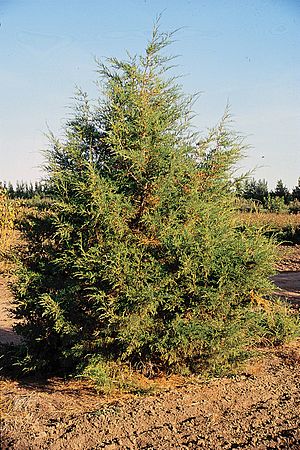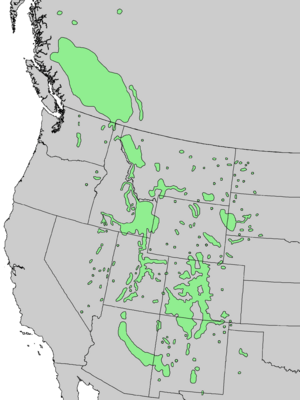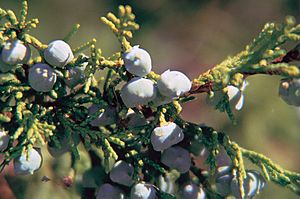Rocky Mountain juniper facts for kids
Quick facts for kids Rocky Mountain juniper |
|
|---|---|
 |
|
| Juniperus scopulorum in North Dakota | |
| Conservation status | |
| Scientific classification | |
| Genus: |
Juniperus
|
| Species: |
scopulorum
|
 |
|
| Natural range of Juniperus scopulorum | |
The Juniperus scopulorum, also known as the Rocky Mountain juniper, is a type of juniper tree. It grows naturally in western North America. You can find it in Canada (in British Columbia and southwest Alberta), and in the United States. In the U.S., it grows from Washington east to North Dakota, and south to Arizona and parts of western Texas. It also grows in northern Mexico.
This tree is an evergreen conifer, which means it keeps its leaves all year round. It likes dry places and often grows with other juniper trees. It usually grows at heights between 500 and 2,700 meters (about 1,640 to 8,860 feet) above sea level. The name scopulorum means "of the mountains," which makes sense for a tree found in the Rocky Mountains!
Contents
What Does It Look Like?
The Rocky Mountain juniper is a small tree. It usually grows to be 5 to 15 meters (about 16 to 49 feet) tall. Sometimes, it can even reach 20 meters (about 65 feet). Its trunk can be up to 1 meter (about 3 feet) wide, and sometimes even 2 meters (about 6.5 feet).
The tree's branches are thin, about 0.7 to 1.2 millimeters (0.03 to 0.05 inches) thick. Its leaves are flat and scale-like, like tiny overlapping plates. They are 1 to 3 millimeters (0.04 to 0.12 inches) long. On new shoots, they can be up to 5 millimeters (0.2 inches) long. Young trees have needle-like leaves, which are longer, about 5 to 10 millimeters (0.2 to 0.4 inches).
The seed cones look like berries. They are round or slightly lobed, about 6 to 9 millimeters (0.24 to 0.35 inches) across. They are dark blue with a light blue-white waxy coating. Each "berry" usually has two seeds inside. These cones take about 18 months to ripen and are a food source for wildlife. The pollen cones, which produce pollen, are smaller, about 2 to 4 millimeters (0.08 to 0.16 inches) long. They release their pollen in early spring.
This tree is dioecious. This means that each tree has either male cones (pollen cones) or female cones (seed cones), but not both.
How Old Can It Get?
Rocky Mountain junipers can live for a very long time! One famous tree, the Jardine Juniper in Utah, is believed to be over 1500 years old. Scientists found a dead trunk in New Mexico that had 1,888 growth rings. This means it lived for 1,888 years! It's thought that other trees in the same area might be even older, possibly over 2,000 years old.
Related Juniper Trees
The Rocky Mountain juniper is closely related to another tree called Juniperus virginiana, also known as the Eastern Redcedar. When their growing areas meet, they often hybridize, meaning they can cross-breed and create mixed trees. They can also hybridize with J. horizontalis, which is a low-growing juniper.
How People Use This Tree
Many Plateau Indian tribes used parts of the Rocky Mountain juniper. They would boil the leaves and inner bark to make a drink that helped treat coughs and fevers. The cones were sometimes boiled into a drink used as a laxative or to help with colds.
Some Native American cultures use the smoke from burning cedar wood. They believe it helps to clear away bad spirits before important ceremonies, like healing ceremonies.
The ripe berries can be eaten in small amounts as an emergency food. They can also be used as a seasoning for meat, similar to sage. If the dried berries are roasted and ground, they can be used as a coffee substitute.
This tree is also popular as an ornamental plant in gardens. A special type called 'Skyrocket' is well-liked because it grows very tall and narrow. However, it can get a fungal disease called cedar apple rust. Because of this, a different type of juniper, J. virginiana 'Blue Arrow', is now often used instead. 'Blue Arrow' has even won an award for being a great garden plant.
The Rocky Mountain juniper is also a popular tree for bonsai in the United States. Bonsai is the art of growing miniature trees in containers.
See also
In Spanish: Juniperus scopulorum para niños




